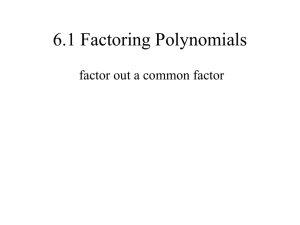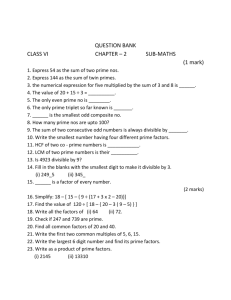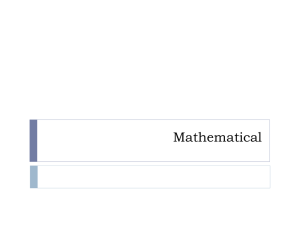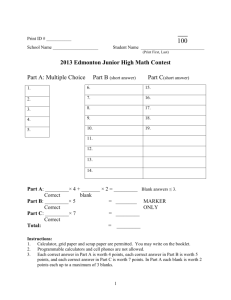Maths - ChandraBala Modi Academy
advertisement
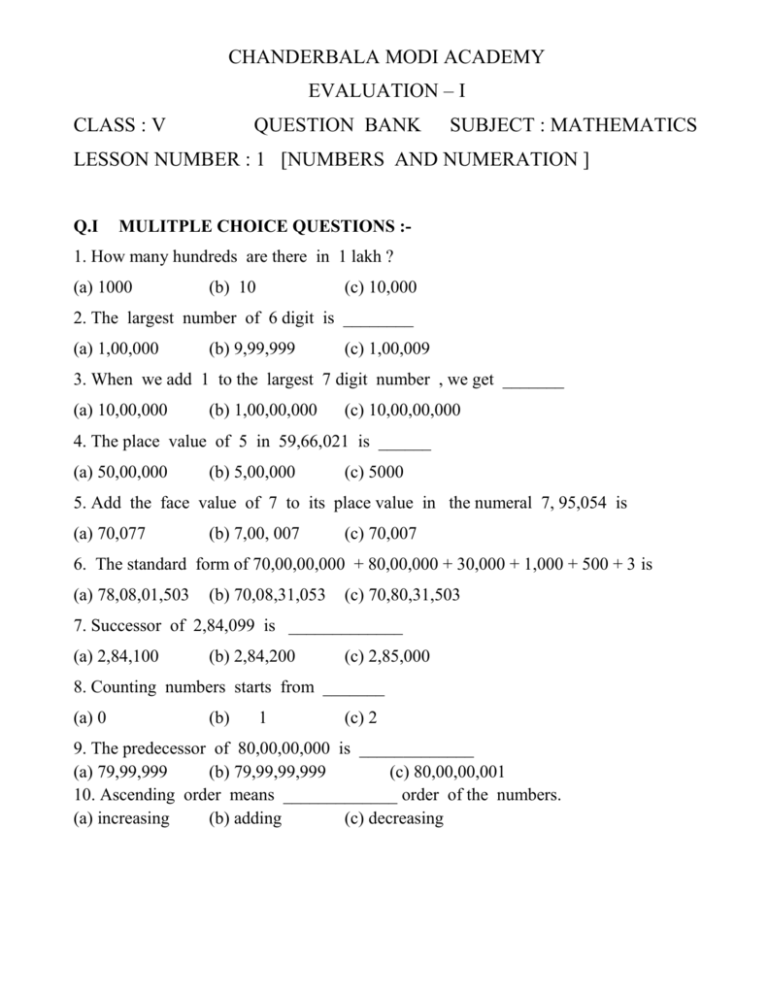
CHANDERBALA MODI ACADEMY
EVALUATION – I
CLASS : V
QUESTION BANK
SUBJECT : MATHEMATICS
LESSON NUMBER : 1 [NUMBERS AND NUMERATION ]
Q.I
MULITPLE CHOICE QUESTIONS :-
1. How many hundreds are there in 1 lakh ?
(a) 1000
(b) 10
(c) 10,000
2. The largest number of 6 digit is ________
(a) 1,00,000
(b) 9,99,999
(c) 1,00,009
3. When we add 1 to the largest 7 digit number , we get _______
(a) 10,00,000
(b) 1,00,00,000
(c) 10,00,00,000
4. The place value of 5 in 59,66,021 is ______
(a) 50,00,000
(b) 5,00,000
(c) 5000
5. Add the face value of 7 to its place value in the numeral 7, 95,054 is
(a) 70,077
(b) 7,00, 007
(c) 70,007
6. The standard form of 70,00,00,000 + 80,00,000 + 30,000 + 1,000 + 500 + 3 is
(a) 78,08,01,503
(b) 70,08,31,053
(c) 70,80,31,503
7. Successor of 2,84,099 is _____________
(a) 2,84,100
(b) 2,84,200
(c) 2,85,000
8. Counting numbers starts from _______
(a) 0
(b)
1
(c) 2
9. The predecessor of 80,00,00,000 is _____________
(a) 79,99,999
(b) 79,99,99,999
(c) 80,00,00,001
10. Ascending order means _____________ order of the numbers.
(a) increasing
(b) adding
(c) decreasing
Q.II
11. Draw an Indian place value chart and enter the digits of the numbers given
below :(i) 23,45,34,980
(ii) 32,45,46,890
(iv) 12,09,45,349
(v) 56,57,67,898
(iii) 56,73,42,456
12. Write in the expanded form :(i) 5,30,078
(ii) 34,56,090
(iii) 45,67,90,365
13. Write in the short form :(i) 3 × 1000000 + 3 ×10000 + 3 ×100 + 3
(ii) 6 ×10000000 + 5 × 100000 + 4 × 10000 + 3 ×1000 + 2 ×100 + 1 × 10 + 3
(iii) 7000000 + 600000 + 80000 + 9000 + 8
(iv) 50000000 + 4000000 + 300000 + 40000 + 2000 + 100 + 20 + 4
14. Answer the following questions :(i) Which is the (a) smallest (b) largest whole number ?
(ii) Which is the (a) smallest (b) largest natural number ?
(iii) How many thousands make a lakh ?
(iv) How many lakhs make one million ?
(v) How many millions make one crore ?
(vi) How many millions make one billion ?
(vii) How many thousands make a crore ?
15. Write a number that satisfies the following conditions.
(i) The smallest 3 – digit number
(ii) The smallest and largest 5 – digit numbers using the digits 3, 7, 0 , 4, 1
(iii) The largest eight digit number.
(iv) The Predecessor of smallest nine digit number.
16. Insert commas suitably and write the names according to International
and Indian system of numeration.
(i) 87650093
(iv) 256190832
(ii) 453127890
(v) 807632100
(iii) 765300987
17. Write the numerals for each of the following using International system of
numeration.
(i) Ninety nine million ,one hundred forty thousand , two hundred thirteen
(ii) Eighty one million , six hundred twenty one
(iii) Four hundred sixty six hundred eleven two hundred forty
(iv) Nine hundred forty six million, two thousand ,three hundred forty five
(v) Two million . eight hundred six thousand , twenty nine
18. Write in ascending order.
(i) 4,35,60,776
; 4,35,06, 716
; 4, 35, 60, 767
; 4, 33, 06, 716
(ii) 50, 06, 71, 234 ; 50, 06. 77, 899 ; 50, 60 , 89 , 899 ; 50,60,18,432
(iii) 1, 34 , 057
; 1, 55.975
; 1, 15 , 567
; 1, 05 , 978
19. In which period and place is the underlined digit in each of the following
numerals?
(i) 89, 90, 76, 544
(ii) 86, 54, 33, 211
(iii) 87, 66, 58, 910
20. Write the place value of the digits 4 and 8 in the following numbers. Use
the Indian system of numeration.
(i) 4, 00, 82, 677
(ii) 58 , 49, 001
(iii) 86 , 76, 03, 425
21. Write the numerals in figures :(i) 10 lakh more than 5,65, 43, 432
(ii) 35 thousand less than 3, 84, 660
(iii) 1 lakh more than 6, 65, 70, 119
*****************************************************************
L.NO-2 - ROMAN NUMERALS
Q.I
Write the following numbers in Roman numerals :
(a) 60
(b) 75
(c) 91
(d) 25
(e) 99
(f) 256
(g) 1005
(h) 3075
(i) 2375
(j) 501
(k) 109
(l) 800
(m) 50
(n) 829
(o) 111
(p) 405
Q.II Match the following Roman numerls with the Hindu – Arabic notation :
(i)
CC
(a)
668
(ii)
CD
(b)
1452
(iii)
DCLXVIII
(c)
192
(iv)
DCCCLX
(d)
900
(v)
MCDLII
(e)
200
(vi)
CM
(f)
400
(vii) M
(g)
3000
(viii) MMM
(h)
860
(ix)
CXCII
(i)
1000
(x)
CVI
(j)
106
Q.III Tick the correct answer :
(i)492
=
DCII
;
MCII
;
CDXCII
(ii)
3223 =
DDCXXIII ;
MMMCCXXIII ;
(iii)
663
DCLXIII
DCCXIII
=
;
MCDXXIII
; CDLXIII
Q.IV Which is greater :
(a)
XXXVII
or
CDII
(b)
CCXX
or
CDXI
(c)
CLVI
or
CXLVI
(d)
XC
or
CM
(e)
MCCL
or
MCXL
Q.V Write Hindu –Arabic numerals for the following Roman numerals :
(a)
CDXLIII
(b)
CCXCVI
(c)
MXXXIX
(d)
MCL
(e)
MMCCCLXX
(f)
CMXC
(g)
DCCCLXIX
(h)
CCX
(i)
MDCXCV
(j)
MMMCX
*************************************************
L.NO- 3 – OPERATION ON WHOLE NUMBERS
Q.I
Fill in the blanks :
1.
2.
To find the missing Minuend the ________ is added to the difference.
To find the missing subtrahend the difference is subtracted from the
_________.
The numbers to be added are called ________.
The numbers to be subtracted are called ______.
The numbers from which the other number is to be subtracted is called
______.
The answer of an addition is called the _________.
1485 x ________ = 2436 x 1485
2772 x ________ = 2772
4385 x ________ = 0
35 x (100 + 37) = (35 x 100) + (35 x ________)
146 x (1000 + 48) = (146 x ______) + (146 x ________).
2718 x 10 = _________
6087 x 1000 = _______
99999 x 2000 = _________
26305 x 800 = _________
3.
4.
5.
6.
7.
8.
9.
10.
11.
12.
13.
14.
15.
Q.II Multiple choice questions :
1.
What should be added to 68965 to get 87013 ?
(a)
2.
17848
(c)
18048
(d) 18068
350035
(b)
353035
(c)
355035 (d) 357035
(c)
2299600 (d) 0
5749 x 5 x 10 x 0 x 8 = _____?
(a)
4.
(b)
3535 x 101 = _______
(a)
3.
17668
229960
(b)
459920
Kamal saved Rs.485 every month. How much did he save in 5 years ?
(a)
Rs.24250
(b)
Rs.26675
(c)
Rs.28560
(d) Rs.29100
5.
4000 x 5000 = _________ ?
(a)
6.
(b)
20 lakh
(c)
2 crore
(d) 2 million
A sack holds 560 onions. How many onions can fit in 148 sacks ?
(a)
7.
2 lakh
54880
(b)
71680
(c)
77280
(d) 82880
(c)
1001
(d) not possible
75765 ÷ 765 = ______ ?
(a)
11
(b)
101
Q.III (a) Arrange in columns and add :
1.
57085639 + 34768596 =
2.
367285109 + 481827825 + 2368789 =
3.
5764239 + 43075786+139608945+96578 =
4.
43268974+6794347+316554 =
5.
7453619+1876984 =
(b)
Find the difference :
1.
Subtract 2736879 from 5342568
2.
5826704 – 3927815
3.
8134205 – 5146307
4.
6010036 – 5419947
5.
12034504 – 8075698
(c )
Simplify :
1.
365432708 – 245036813 + 8432608
2.
72043 – 14632 – 20070
3.
31460735 + 2057063 – 10456032
(d)
Find the number which is ,
1.
6,000 more than 97, 24, 315
2.
24,630 more than 8,57,04,316
3.
2,000 less than 34,50,26,893
4.
What must be added to 5678469 to make 6164324 ?
5.
What must be subtracted from 9005413 to get 7906547 ?
Q.IV (a) Multiply :
1.
2.
3.
4.
5.
6.
7.
8.
5347 x 486
6854 x 89
26857 x 68
9675 x 925
23689 x 137
12456 x 784
19847 x 354
12874 x 1386
(b)
Divide and find the quotient and remainder :-
1.
2.
3.
4.
5.
6.
7.
8.
83254 ÷ 58
547802 ÷ 97
673900 ÷ 86
33624 ÷ 137
598613 ÷ 243
1808016 ÷ 359
2265737 ÷ 479
5419307 ÷ 396
(c)
Find the Dividend when :i. Divisor = 187, Quotient = 3078, Remainder = 96
ii. Divisor = 429, Quotient = 52378, Remainder = 248
iii. Find the quotient and the remainder, when the largest 7 digit number is
Divided by the largest 3 digit number.
iv. Find the quotient and the remainder when the smallest 8 digit number is
divided by the largest 2 digit number.
Q.V
SOLVE THE PROBLEMS :-
1.
The number of persons who visited the holy shrine of Mata Vaishnov Devi
during last two consecutive years was 6378907 and 7865089 respectively. How
many persons visited the shrine during these two years ?
2.
Last year, three sugar factories in a town produced 23807575 bags, 19728686
bags and 8962347 bags respectively.
How many bags in all were produced by
all the three factories during last year ?
3.
In a particular year, the male population of a city was 2359324 more than the
female population. The number of females was 6813675. What was the male
population of the city during that year ?
4.
In a particular year an industry produced 6736265 bicycles. Next year, the
number of bicycles was 1374589
more than those produced in the preceding
year. How many bicycles were produced during these two years ?
5.
In an Examination, 506212 candidates could get through. Out of these,
197538 passed with first division, 238604 passed in second division. How many
passed in third division ?
6.
A factory produced 5365129 switches in a particular year and 6010016
switches in the following year. Find the increase in the production of switches.
7.
The sum of two numbers is 13604050. If one of the number is 7824361, find
the other number.
8.
A truck can carry 6785 Kgs. Of goods. How much can 759 trucks carry ?
9.
There are 1483 bags of wheat in a godown. If each bag weighs 108 Kgs., find the
total weight of these bags.
10. A bundle of rope measures 548 meters. How much rope will be there in 2367
such bundles ?
11. 7359105 pencils are packed equally in 845 boxes. How many pencils are packed
in one box ?
12. The cost of 736 quintals of wheat is Rs.1214400. Find the cost of one quintal of
wheat.
13. A calculator costs Rs.845/-. A shopkeeper collected Rs.742755/- by selling the
calculators in one month. How many calculators did he sell in one month ?
14. 950589 persons visited Appu Ghar in 327 days. How many persons on an
average visited Appu Ghar in one day ?
Q. VI: Simplify by using BODMAS rule :1.
20 – {18 ÷ (7 – 2 + 1) }
2.
23 – [6 + {8 – (9 – 6) {]
3.
12 – [6 ÷ 3 + {8 ÷ 2 x (8 – 6) {]
4.
40 – [12 + {16 – (12 ÷ 3) {]
5.
[{64 – (12 + 13) {÷ 3] + 15
Q. VII : Unitary method :
1.
The train fare from Chennai to Mumbai for 6 passengers is Rs.1122. What is
the fare for 10 persons ?
2.
18 buses carry 936 passengers. How many passengers will 25 buses carry ?
3.
12 Kgs. Of Potatoes cost Rs.84. How much will Mr. Bhaskar have to pay if he
wants only 5 Kgs. of Potatoes ?
4.
Mr. Rao has a family of 5. He spend Rs.1650 per month on food. Mr.Srivastava
has a family of 8. If both families eat the same kind of food, how much Mr. Srivastava
spend on food ?
5.
In a factory, 20 workers make 360 toys in a day, working 8 hours a day. Find the
number of toys made in a day of :
(a)
5 workers are on leave
(b)
All workers are present and the working hours are increased from 8 hours
to 12 hours a day.
L.NO- 4
MULTIPLES AND FACTORS
Q.I
Fill in the blanks .
1.
_____________ is a factor of every number.
2.
The least prime number is ___________.
3.
The smallest odd composite number is _________.
4.
Each prime number has exactly _______ factors.
5.
_________ is neither prime nor composite.
6.
_________ is the only even prime number.
7.
The largest two digit prime number is _________.
8.
All even numbers are divisible by _______.
9.
Two prime numbers which differ by 2 are called _________primes.
10.
Numbers which have more than two factors are called _________numbers.
Q.II (a) Which of the following numbers are prime numbers ?
1 , 11 , 21 , 57 , 67 , 19 , 63 , 83 , 89
(b) Which of the following numbers are composite numbers ?
79 , 97 , 51 , 61 , 87, 81 , 78 , 93, 47
(c)
List all prime numbers between 1 and 50.
(d)
List prime numbers between 51 and 100.
(e)
List all twin –primes between 1 and 50.
(f) Write the prime factrisation of each of the following numbers using
division by prime numbers :(i) 60
(ii)
84
(iii)
180
(iv) 210
(g)
Give four examples of pairs of Co-primes.
(h)
Write first six multiples of :
(i)
6
(ii)
11
(iii)
19
(iv)
21
(i)
(j)
Write all the factors of e ach of the following numbers :(i)
18
(ii)
28
(v)
220
(vi)
180
(iii)
32
(iv)
45
Write all even numbers between (i) 73 ans 87
(ii) 519 and 531
(k)
Write all odd numbers between (i) 64 and 80 (ii) 624 and 640
Q.III
(a)
TEST DIVISIBILITY METHOD :
Which of the following numbers are divisible by 2 :
(i)
(b)
(ii)
23571
(iii)
42105
(iv)
31547
894
(ii)
1056
(iii)
24842
(iv)
97312
2730
(ii)
3206
(iii)
27905
(iv)
9915
7038
(ii)
17703
(iii)
7812
(iv)
8721
1372
(ii)
10658
(iii)
62156
(iv)
279136
50553
(ii)
12501
(iii)
3499
(iv)
20367
1155
(ii)
2960
(iii)
8740
(iv)
2068
Which of the following numbers are divisible by 11 :
(i)
(j)
16339
Which of the following numbers are divisible by 10 :
(i)
(i)
5694
Which of the following numbers are divisible by 9:
(i)
(h)
(iv)
Which of the following numbers are divisible by 8 :
(i)
(g)
843
Which of the following numbers are divisible by 6 :
(i)
(f)
(iii)
Which of the following numbers are divisible by 5 :
(i)
(e)
670
Which of the following numbers are divisible by 4 :
(i)
(d)
(ii)
Which of the following numbers are divisible by 3 :
(i)
(c)
976
17622
(ii)
58564
(iii)
101011
(iv)
20833
Which of the following numbers are divisible by 12 :
(i) 5532
(ii)
28956
(iii) 13345
(iv)
9864
**********************************************************
L.NO- 5
Q.I
H.C.F AND L.C.M
Find the H.C.F of :
(a)
16 and 24
(d)
8, 20 and 32
(b)
18 and 27
(c)
(e) 14,28 and 35
32 and 40
(f) 16, 20 and 36
Q.II Find by prime factorization, the H.C.F of :
(a)
45 and 60
(b)
36 and 54
(c)
48 and 60
(d)
75 and 90
(e)
52 and 78
(f)
72 and 108
(g)
42 and 112
(j)
42, 63 and 105 (k) 91, 49 and 112
(h) 54 and 114 (i) 168 and 216
Q.III Find the H.C.F of the following numbers, using prime factorization :
(a)
24, 40 and 56
(d)
144, 180 and 252
(b)
18 and 48
(c)
112, 140 and 168
Q.IV Find the H.C.F of the following numbers by the common division method:
(a)
24 and 80
(b)
18 and 48
(c)
(d)
48, 80 and 96
(e)
42, 70 and 112
165 and 220
(f) 144, 180 and 192
Q.V Find the H.C.F of the following numbers, using division method :
Q.VI
(a)
96 and 120
(d)
575 and 920
(b)
81 and 108
(c)
252 and 576
Find the L.C.M. of the following numbers, using prime factorization method :
(a)
18, 24
(b)
36, 45
(c)
63, 105
(d)
28, 56, 84
(e)
36, 54, 81
(f)
27, 54, 90
Q.VII Find the L.C.M. of the given numbers, using short division method :
(a)
25, 30
(b)
32, 48
(d)
28, 42, 56
(e)
75, 100, 150
(g)
90, 135, 180
Q.VIII
(a)
(h)
(c)
42, 70
(f) 96, 144, 192
102, 136, 170 (i) 64, 72, 96, 108
Find the H.C.F and L.C.M of :
87 and 145
(b)
161 and 207
(c)
270 and 450
Q.IX The H.C.F of two numbers is 12 and their L.C.M is 180. If one of the numbers is
36, find the other.
Q.X The H.C.F of two numbers is 30 and their L.C.M is 2310. If one of the numbers
is 210, find the other.
Q.XI The product of two numbers is 2925 and their H.C.F is 15. Find the L.C.M of
these numbers.
Q.XII The product of two numbers is 3750 and their L.C.M is 150. Find the H.C.F of
these numbers.
Q.XIII Find the largest number which divides 209 and 260 leaving remainder 5 in
each case.
Q.XIV Two ropes of lengths 16 m and 24 m are to be cut into small pieces of equal
lengths. What will be the maximum length of each piece ?
Q. XV Three drums contain respectively 36 litres, 45 litres and 72 litres of oil. Find
the capacity of the largest container which can measure the content of each drum an
exact number of times.
Q.XVI Find the least number which is exactly divisible by each one of the numbers
12, 16 and 24.
Q.XVII Find the least number of stones so that heaps of 15, 20 or 30 stones can be
made.
Q.XVIII Six bells commerce tolling together and toll at intervals of 2, 4, 6, 8, 10 and 12
seconds respectively. After how much time will they toll together again.
L.NO – 6 – NUMBER LINE
Q. I
Fill in the blanks :-
1. The set of negative numbers and whole numbers is called as ______________.
2. Absolute value of –58 is ______.
3. The smallest positive integer is __________.
4. The greatest negative integer is __________.
5. On the number line , negative integers lie on the ________ of 0.
6. __________ is greater than every negative integer and smaller than every
positive integer.
Q.II Write the opposite of the following statements :(i) A decrease of 8.
(ii) A loss of Rs. 7
(iii) Losing a weight of 5 kg.
(iv) 10 km below sea level.
(v) 50C above freezing point.
(vi) A withdrawal of Rs. 100
(vii) Spending Rs. 500
(viii) Going 6 m to the West.
(ix) –24
(x) +34
Q.III Indicate the following using ‘+’ or ‘–‘ sign :(i)
(ii)
(iii)
(iv)
(v)
(vi)
(vii)
(viii)
A loss of Rs. 300
A gain of Rs. 500
70C above freezing point.
Increase of 8.
3 km below sea level
2 km above sea level
A withdrawal of Rs. 500
A deposit of Rs. 1200
Q.IV Mark the following integers on the number line :(i)
(iv)
– 4 to 0
5 to –10
(ii) –3 to 3
(v) –11 to –6
(iii) 0 to –5
Q.V Write all integers between :(i)
0 and 5
(iv) –11 and –6
(ii) –8 and 0
(iii) –4 and 4
Q.VI Write the predecessor and successor of the following integers :(i)
(iv)
–30
–4
(ii)
(v)
–25
–18
(iii) 10
(vi) –40
Q.VII Write the following integers in ascending order :(i)
(ii)
(iii)
(iv)
6 , –6 , –1 , 0 , 9
–22 , 13 , 0 , –5 , –99 , –2
–16 , 16 , –362 , –500 , 166
–364 , –514 , 103 , 414 , –6
Q.VIII Write the following integers in descending order.
(i)
(ii)
(iii)
(iv)
0 , 8 , –2 , 10 , –131 , 37
50 , –54 , –9 , 0 , –3 , 10
–72 , –82 , 35 , 0 , –6 , –14
–366 , –516 , 101 , 412 , –8
Q.IX Which number is larger in each of the following pairs ?
(i)
0 , –3
(iv) –6 , 3
(ii) –4 , –6
(v) –17 , 9
(iii) –999 , 9
(vi) –366 , –914
*******************************************************
